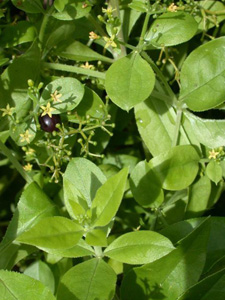Madder Red
No mader, welde, or wood no litestre
Ne knew; the flees was of his former hewe;
Ne flesh ne wiste offence of egge or spere.
No coyn ne knew man which was fals or trewe,
No ship yet karf the wawes grene and blewe,
No marchaunt yit ne fette outlandish ware.???Geoffrey Chaucer, The Former Age, ll. 17???22
Above, left: Dyer’s madder, a rough perennial herb native from the Eastern Mediterranean to Central Asia, grows in the bed devoted to plants used in medieval arts and crafts in Bonnefont cloister. The dried and pulverized roots of madder afforded a strong, fast red. Right: Detail from The Unicorn Defends Itself (from the Unicorn Tapestries). A range of colors???from pinks through bright reds, purplish reds, and oranges???could be achieved with madder, depending on the mordant used and the way in which the madder was combined with other colorants. (See Collections for more information about this work of art.)
The antiquity of the dyer’s craft is conveyed by Chaucer’s inclusion of the ignorance of madder, weld, and woad, the holy trinity of medieval dye plants, in his description of a period so remote and so devoid of the arts of civilization as to predate the use of knives, spears, coins, and ships. The use of madder is especially ancient, as demonstrated by this fragment of an Egyptian leather quiver in the Museum’s collection that may date to the 3rd millennium B.C.


